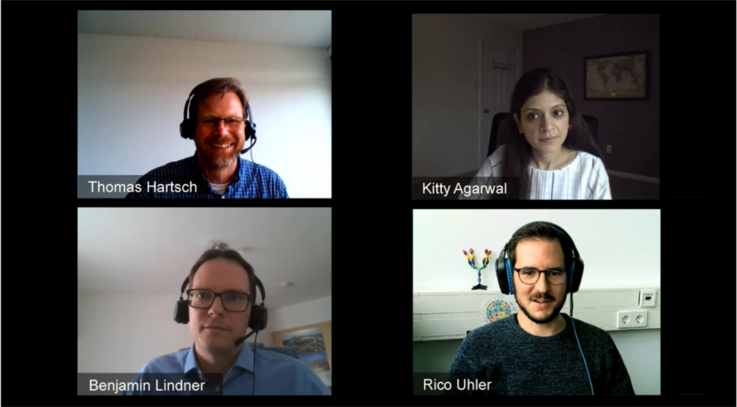
Open Forum on NGS-Based Cell Line Development
Industry Workshop on the Present and Future of NGS in CLD, co-hosted by Boehringer Ingelheim
Sign-Up to Get Involved in Upcoming Industry WorkshopsSummary of Event on April 29th, 2021
In collaboration with Boehringer Ingelheim, Genedata organized and co-hosted an industry workshop bringing together experts of the biopharma R&D industry to facilitate knowledge sharing on key topics. This interactive event was attended by representatives from 22 leading biopharmaceutical companies and featured talks focused on multi-omics data integration and cell line characterization using NGS. During the event, discussions were centered on the different applications of NGS in CLD, digitalization and collaborative efforts to drive faster NGS adoption. Attendees had the opportunity to raise questions and participate in an engaging discussion with the speakers to learn about challenges experienced and best practices used.
Presentations
Introduction
Jan Visser, Vice President Bioprocess Development Biologicals, Boehringer Ingelheim
To kickstart the event, Jan Visser delivered a talk focused on the presence and future of NGS in cell line development. He introduced the internal pipeline for cell line development at Boehringer Ingelheim and highlighted the specific NGS applications currently in use. The presented applications demonstrated the strength and possibilities of NGS in cell line development, which was further discussed in the next talks.
Cell Line Characterization 2.0:
Implementation of Sequence Variant Analysis via RNA-seq and Future Perspectives
Benjamin Lindner, Senior Data Scientist, Boehringer Ingelheim
The genetic characterization of CHO production cell lines is a crucial requirement for the production of therapeutic biologics. Current gold standards are quite classical molecular biological methods e.g. Sanger sequencing. Here, we present RNA-seq as an alternative to Sanger sequencing to confirm the transgene’s transcript sequence. We demonstrate that RNA-seq provides superior sensitivity for mutation detection as well as high specificity, repeatability and robustness. Further, it streamlines the laboratory workflow and is scalable up to 96 samples per batch. It also offers the possibility of unsupervised automatic bioinformatic analysis reducing the uncertainty of personal evaluation of Sanger sequences. In addition, RNA-seq could potentially be used to screen for clones with high transgene expression or to identify transcriptionally unstable clones. Future applications may comprise the identification of problematic transcripts affecting CHO stability, product quality and platform fit as well as single cell sequencing to assess the cellular heterogeneity of CHO clones early on.
Comparison of NGS-based Methods for the Characterization of Gene Knockouts
Rico Uhler, Data Scientist, Cell Line Development, Octapharma Biopharmacueticals
To improve the pharmacokinetic properties of proteins produced in human embryonic kidney 293-F (HEK 293-F) cells, their N-glycosylation machinery was engineered by simultaneous knock-out of N‑acetylgalactosamine transferases B4GalNT3 and B4GalNT4. From the knock-out pools single-cell clones of either single KOs (B4GalNT3 or B4GalNT4) or double-KOs (B4GalNT3+4) were generated and amplicon sequencing was applied for genotype characterization. In the selected KO clones, we identified only one or two small indels per targeted gene – a rather unexpected finding based on the pseudotriploidity of the HEK 293-F cell line. However, a more thorough analysis using targeted locus amplification revealed complex genomic rearrangements that were not detectable by amplicon sequencing. Subsequent N‑glycan analysis demonstrated the absence of N-acetylgalactosamine on proteins produced in the double knock-out clones, and in combination with the genomic data confirmed functional knock-outs in all clones.
Open Discussion

The event concluded with a lively discussion. Panelists addressed topics regarding the values of NGS and the challenges experienced during its implementation in cell line development. While sharing experiences and best practices, panelists also answered additional questions from the audience concerning scientific and regulatory matters. All participants were welcome to engage and get involved in the discussion on how the industry can collaborate and share knowledge.
Agenda of Open Forum on April 29th, 2021
| EDT | CEST | Thursday, April 29, 2021 |
|---|---|---|
| 9:00 am | 3:00 pm | Welcome and Introduction to the Participants Jan Visser, Vice President Bioprocess Development Biologicals, Boehringer Ingelheim Thomas Hartsch, Head of Selector Business at Genedata |
| 9:10 am | 3:10 pm | Cell Line Characterization 2.0: Implementation of Sequence Variant Analysis via RNA-seq and Future Perspectives Benjamin Lindner, Senior Data Scientist, Boehringer Ingelheim |
| 9:35 am | 3:35 pm | Next Generation CLD: Integration of Multi-omics Data and Applications Kitty Agarwal, Principal Scientist, Biologics Process Development, Bristol-Myers Squibb |
| 9:55 am | 3:55 pm | DEMO: CRISPR for Cell Line Engineering Devon Ryan, Scientific Consultant, Genedata |
| 10:05 am | 4:05 pm | Comparison of NGS-based Methods for the Characterization of Gene Knockouts Rico Uhler, Data Scientist, Cell Line Development, Octapharma Biopharmacueticals |
| 10:25 am | 4:25 pm | DEMO: Simplified Verification of Integration Sites in CLD Giuseppe Semplicio, Scientific Consultant, Genedata |
| 10:35 am | 4:35 pm | Open Discussion All speakers, moderated by Genedata |
| 11:00 am | 5:00 pm | End of Event |
Disclaimer: “The purpose of our gathering and discussions is to start a pre-competitive R&D collaboration and discuss best practices using NGS to accelerate cell line development in biopharma R&D. We consider our discussions to be pre-competitive in nature as the best practices can be used very broadly in the industry. Please keep the conversation to this topic and refrain from bringing up topics that could be considered anti-competitive under antitrust/competition laws, such as pricing.”